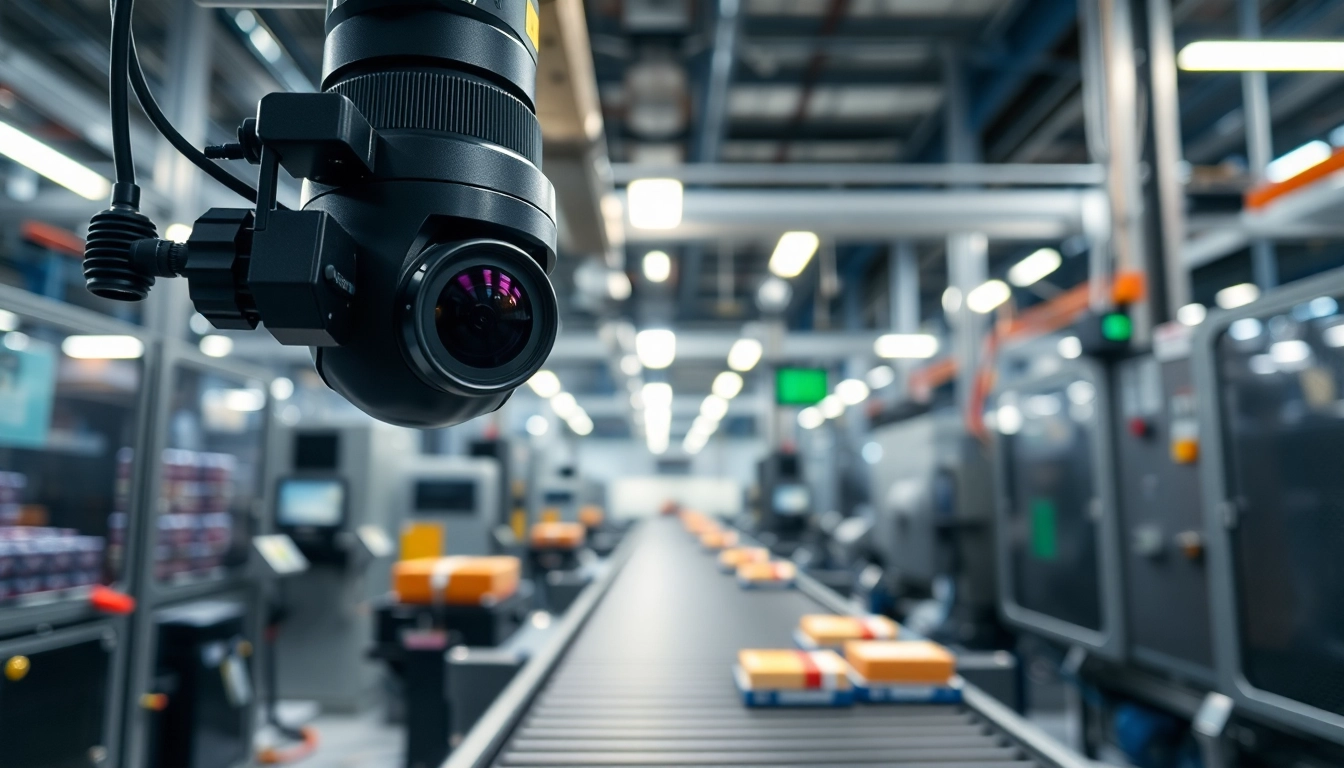
What is Machine Vision?
In the modern landscape of technology, machine vision stands out as a transformative force across various industries. It refers to the technology and methodologies that enable machines to interpret and act upon visual information. By seamlessly integrating hardware and software systems, machine vision facilitates automatic inspection, analysis, and decision-making processes that were once solely the domain of human operators.
Definition and Basic Principles
Machine vision can be defined as the capability of computer systems to interpret visual data captured through imaging sensors. This involves several core principles, which include:
- Image Acquisition: The process begins with capturing images through cameras and sensors which may include specialized lenses and lighting.
- Image Processing: Once captured, the visual data undergoes processing through algorithms that can identify patterns, features, or defects.
- Decision Making: The processed information is then analyzed to make decisions based on predetermined criteria, facilitating tasks such as quality control, sorting, and tracking.
Machine vision mirrors human eyesight but engages far more than just recognition; it incorporates analysis and actionable insights from the visual data captured.
Components of Machine Vision Systems
To understand how machine vision systems operate, it’s essential to recognize the fundamental components that constitute these systems:
- Cameras: The primary instruments for image capture, which come in various types, including monochrome, color, and thermal imaging cameras.
- Lighting Systems: Essential for enhancing image quality, different lighting techniques (e.g., backlighting, ring lighting) help in highlighting features of interest.
- Image Processors: These devices analyze the visual data and apply algorithms for tasks like pattern recognition and image filtering.
- Software Interfaces: Various software solutions facilitate real-time data interpretation, user interface management, and system integration.
- Communication Interfaces: They enable the machine vision system to communicate and integrate with other machinery or networks.
Applications in Various Industries
Machine vision is utilized across numerous sectors, showcasing its versatility:
- Manufacturing: Employed for quality control, defect detection, and assembly line automation.
- Healthcare: Assists in diagnostic imaging and automates the analysis of medical images.
- Aerospace: Ensures precision in assembly and part inspection, critical for safety and reliability.
- Automotive: Used in inspecting components, guiding assembly robots, and facilitating autonomous driving technologies.
- Food and Beverage: Enhances safety and quality assurance by monitoring packaging and detecting contaminants.
The adaptability of machine vision allows it to enhance efficiency and precision across diverse applications, substantially reducing human error and increasing throughput.
Benefits of Implementing Machine Vision
The advantages of adopting machine vision systems are profound, impacting productivity, quality, and operational costs positively.
Quality Control Improvements
Accurate and consistent quality control is one of the prime benefits of machine vision implementation. By utilizing automated systems, companies can:
- Detect Defects Early: Automated inspections significantly lower the chances of defective products reaching consumers.
- Ensure Consistency: Machine vision systems maintain uniform standards that surpass manual inspections.
- Generate Data Insights: Comprehensive analytics reveal trends over time, allowing for proactive quality management practices.
Increased Efficiency and Automation
Machine vision streamlines processes by enhancing efficiency through automation. Key points include:
- Speed: Machines can operate much faster than humans, leading to reduced cycle times.
- Continuous Operation: Unlike humans, machine vision systems can operate continuously without the need for rest, increasing productivity levels.
- Scalability: These systems can be tailored to scale with production demands, accommodating changes rapidly without impacting performance.
Cost-Effectiveness and ROI
The financial implications of machine vision systems often result in strong ROI due to several factors:
- Labor Costs: Automation reduces labor costs related to manual inspections, freeing workers for higher-value tasks.
- Reduced Waste: More accurate inspections result in less product waste, aiding sustainability efforts.
- Lower Compliance Costs: Systematic quality assurance minimizes risks of product recalls and safety violations, which can be financially devastating.
Types of Machine Vision Systems
The landscape of machine vision is diverse, categorized into various systems based on functionality and application.
2D vs. 3D Machine Vision
Machine vision systems predominantly fall into two categories:
- 2D Vision Systems: Focus on capturing flat images and are widely used for surface inspections and barcode scanning.
- 3D Vision Systems: Utilize depth perception to measure complex shapes and volumes, ideal for applications requiring precise spatial analysis.
The choice between 2D and 3D vision systems depends on the unique requirements of the application at hand, with each offering distinct advantages.
Embedded Vision Systems
Embedded vision integrates neural networks and vision processing capabilities directly into devices. Key characteristics include:
- Compact Design: Embedded systems can be integrated into machinery without needing extra space.
- Real-Time Processing: Data is processed on-site, providing immediate feedback and actions.
- Versatility: Used in everything from consumer products to industrial automation systems.
Smart Cameras and Software Solutions
Smart cameras incorporate both hardware and software, offering comprehensive solutions for specific tasks:
- All-in-One Systems: Smart cameras reduce setup complexity by combining image capture and processing.
- Advanced Algorithms: They frequently employ machine learning and AI for enhanced detail detection.
- Easy Integration: These systems are designed to seamlessly integrate into existing production lines.
Challenges in Machine Vision Implementation
While the benefits of machine vision systems are clear, potential challenges may arise during implementation:
Technical Limitations and Solutions
Technical hurdles can be encountered, such as:
- Lighting Variability: Inconsistent lighting conditions can adversely affect image capture quality; mitigating this involves dedicated lighting setups.
- Complex Algorithm Requirements: Developers may face difficulties in creating accurate algorithms; ongoing training and iterations are essential to enhance performance.
- Camera Calibration: Ensuring accuracy through proper calibration is vital; automated calibration processes can minimize errors.
Integration with Existing Systems
Integrating new machine vision technology with legacy systems can be challenging:
- Compatibility Issues: Existing hardware may not support modern systems; careful assessment before implementation can alleviate this.
- Data Management: Effective data integration requires robust communication protocols; maintaining data flow is critical for operational efficiency.
- Training Needs: Employees must be trained to utilize new systems; continuous training programs can enhance workplace adaptability and efficiency.
Maintaining and Upgrading Systems
Regular maintenance of machine vision systems is crucial, highlighted by several challenges:
- System Downtime: Regular maintenance must align with production schedules to minimize impact.
- Software Updates: Upgrading to the latest software versions can be complicated; a systematic upgrade approach will ensure continued system reliability.
- Performance Metrics: Continuous monitoring of system performance allows for timely upgrades and maintenance, ensuring optimal performance.
The Future of Machine Vision
The evolution of machine vision is poised to accelerate due to emerging trends and technological advancements, reinforcing its significance in the industrial landscape.
Emerging Trends and Technologies
As technology progresses, several noteworthy trends are shaping the future of machine vision:
- AI and Machine Learning: The integration of AI enhances the capability of machine vision systems by enabling more complex data analysis and improved pattern recognition.
- Edge Computing: Processing data closer to the source reduces latency, making real-time analytics more feasible for critical decision-making.
- Cloud Integration: Leveraging cloud storage and computing provides scalability and access to vast amounts of data for training systems and improving performance.
Machine Vision and AI Integration
The combination of machine vision with AI plays a crucial role in pushing the boundaries of what these systems can accomplish, including:
- Predictive Maintenance: Machine learning algorithms can analyze historical data to predict when machines will require maintenance.
- Enhanced Image Analysis: AI algorithms facilitate nuanced understanding through advanced pattern recognition and anomaly detection.
- Self-Optimizing Systems: Future systems may adapt and optimize processes autonomously based on continuous data analysis.
Predictions for the Industry
Looking forward, the machine vision industry is expected to grow exponentially, poised for several transformative changes:
- Broader Adoption: As costs decrease and technologies become more accessible, adoption across smaller businesses will rise.
- Interoperability Standards: Development of widely accepted standards will ease integration challenges, further driving adoption.
- Application Expansion: Machine vision’s role in new fields such as agriculture, cybersecurity, and environmental monitoring will see increased relevance.
In conclusion, machine vision is more than a mere technological advancement; it is a pivotal component of modern industrial operations that enhances productivity, minimizes waste, and elevates quality control. As businesses continue to evolve in an increasingly competitive market, embracing and investing in machine vision systems will undoubtedly be key to sustaining growth and innovation.







